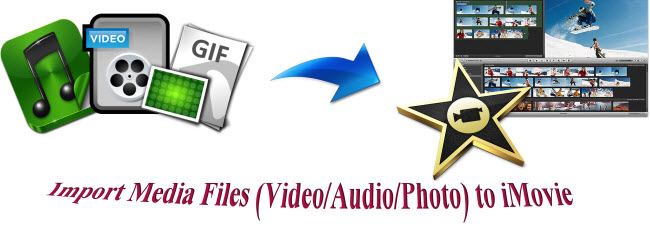With the editing program iMovie, you can import a variety of media files including audios, videos, photos and graphics files to it for professional and further editing. These media files may come from a hard disk of your computer, an external storage device connected to your computer, a memory card inserted in your computer’s card slot or a card reader, or an existing hard disk on your home or other computer network.

Then how to use iMovie to import media files?
Part I. Import videos to iMovie
Videos from tape-based camcorder
Step 1. Connect camcorder to Mac
Launch iMovie, and connect your camcorder to Mac with the supplied cable and then turn the camcorder on. Set the camcorder to VTR/VCR mode. An “Import” window will pop up.
Step 2. Choose “Automatic”/ “Manual” import
The “Automatic” import allows you to import all of your video files on tape while the “Manual” import allows you to add the video footage you want. No matter which one you want to choose, click “Import” to add videos to iMovie.
Step 3. Add videos
After finishing the above two steps, add your videos to an existing event. If it is the first time you imported videos to iMovie, create a new event for you’re the videos you want to import.
Videos from memory-based camcorder
Step 1. Connect camcorder to Mac
Launch iMovie, and connect your camcorder to Mac with the supplied cable and then turn the camcorder on. Set the camcorder to PC Connect mode. Then an “Import” window will pop up.
Step 2. “Automatic”/ “Manual” import
The “Automatic” option allows you to import all of your video clips while the “Manual” option enables you to import the video clips you want.
Step 3. Add videos to a New Event/an Existing Event
After checking the video clips you want to import, add them to an Existing Event or create a New Event to store them.
Import local videos on Mac
You may think about importing video files stored on your Mac to iMovie. Please note that before importing local videos to iMovie, please make sure whether the video formats are well supported by iMovie.
iMovie supported video formats: MPEG-4, QuickTime (*.mov), MPEG-2, AVCHD, DV/HDV.
When importing the video whose format is compatible with iMovie, just click “File” >“Import” >“Movies” on main UI of iMovie.
When coming across video formats incompatible with iMovie such as MKV, VOB, M2TS, and MTS, an iMovie video converter will do you a big favor by transcoding and converting those incompatible videos to iMovie supported video formats.
Part II. Import audios iMovie
Step 1. Open “Music and Sound Effects” interface
Open “Music and Sound Effects” interface by clicking “Window” and “Music and Sound Effects.”
Step 2. Add audios
Click the dropdown menu under the “Music and Sound Effects” option, and find the audios you want to import to iMovie by choosing a folder or an application organizing music like iTunes. Click the audio clips to Timeline by dragging them to the timeline area.
Part III. Import photos to iMovie
Step 1. Open “Photos” interface
Open “Photos” interface by clicking “Windows” and “Photos.”
Step 2. Add photos
Click the dropdown list under “Photos” option, and find the photos by choosing photo apps like iPhoto and PhotoBooth. Then photos contained in this app will be shown on “Photos” interface. Drag the photos you want to import to the project to timeline area. And then you can edit your photos.
You can also import media files to editing programs like Adobe Premiere Pro. In addition to different media files, you can also get a Blu-ray movie edited in iMovie.